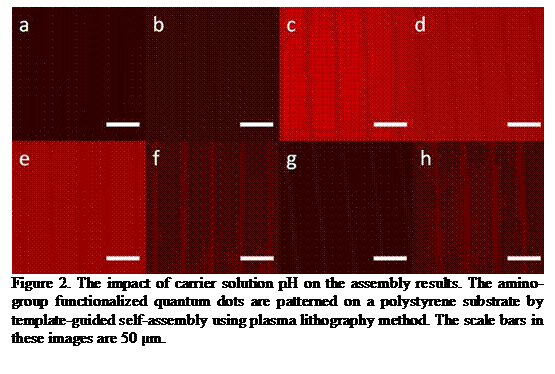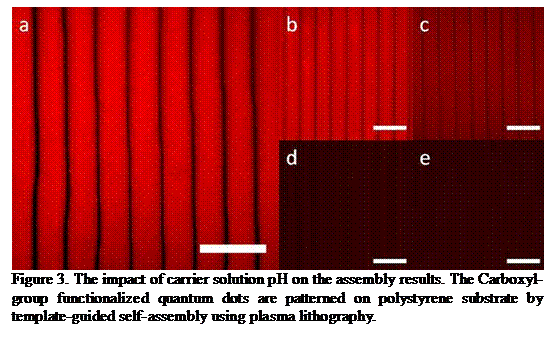AmericanChemicalSociety.com
Reports: G7 47507-G7: Diffusion of Structured Polymers in Confined Environments
Pak Kin Wong, University of Arizona
The overall goal of this project is to elucidate the governing interactions between dendrimers and micro/nano environments. The fundamental understanding will eventually lead to dramatic improvement in the implementation of dendrimeric materials for petroleum industry. It is known that dendrimers can work as additives to oil, such as dendrimer-coldflow-improver additive. Furthermore, aqueous polymer solutions are often used to sweep oil out of natural porous media in oil recovery. The complex interactions between these structured molecules and the substrates, however, are unclear. To investigate these fundamental interactions between structural molecules and micro/nano environments, we are systematically studying the assembly process of dendrimers and other molecules on plasma lithography patterned surface. Template-guided self-assembly using plasma lithography is an effective method to pattern molecules and other nano-materials on various substrates. In the last funding year, we developed a method to pattern dendrimers. In this funding period, we tested the versatility of this method by trying different materials and substrates and contrasted the fundamental assembly processes. In addition, by adjusting the pH of the carrier solution, we systematically investigated the solution conditions necessary to control the amount and type of binding of the patterned materials to the substrate surface.
Different materials and substrates were tested to compare and elucidate the binding process of different structural molecules. First, FITC tagged poly-l-ysine, a kind of polyelectrolyte, was patterned on a PDMS substrate using plasma lithography, as shown in Figure 1. The poly-l-ysine is dissolved in a PBS solution at a concentration of either 0.1 or 0.14 g/ml. The ratio of elastomer to polymerizer of the PDMS substrate was 10:1. Patterning is achieved by the PDMS substrates being covered by a microscale mold that selectively shields the surface and provides channels in which plasma can flow and react with the surface. Thus a chemically modified surface can be produced. After being treated by plasma lithography, the PDMS substrates are soaked in the solution for 15 minutes and rinsed with DI water for 30 seconds. Second, creation of a multilayer of poly-l-ysine and bovine serum albumin (BSA) was tested. Using the method mentioned above, the substrates are soaked in the poly-l-ysine solution, BSA solution, and poly-l-ysine solution for 15 minutes in this order. When the substrates were taken out of the solution, it was rinsed in D.I. water for 30 seconds. The poly-l-ysine and BSA can be assembled layer by layer on the plasma lithography treated PDMS substrate selectively, as shown in Figure 1b.
Another type of self-assembly was achieved by using different types of quantum dots. Amino- and carboxyl-modified colloidal quantum dots are patterned on the polystyrene substrates using this method similar to the patterning with poly-l-lysine. The quantum dot solution is first diluted in PBS at a ratio of 1:200 and after the polystyrene is treated by plasma lithography, the substrate is soaked in the quantum dot solution for 24 hours. The substrate is then rinsed with DI water 3 times for 30 seconds per rinse to remove unbound and excess quantum dots. The assembly result is shown in Figure 1c and d. To optimize assembly results, the pH was systematically adjusted in order to verify the assembly results of the colloidal quantum dots. Acetic acid and sodium hydroxide were added into the carrier solution of the quantum dots to adjust the pH. The quantum dots are functionalized by amino or carboxyl group, so they are either positively or negatively charged. A florescent microscope is used to observe the assembly results. For both kinds of quantum dots, as shown in Figure 2 and Figure 3 respectively, pH influences the assembly results dramatically. The grey value difference of light intensity measured between the plasma treated area and untreated areas, which represents the assembly result, is reduced as the pH increases, as shown respectively in Figure 4 (a) and (b). For the amino-modified quantum dots, this change comprises a decrease in grey value difference, while for the carboxyl-modified quantum dots the change displays a peak in grey value and hence assembly. At acidic or neutral pH values, the quantum dots are patterned on the plasma treated area. However, the quantum dots are patterned on the non-plasma treated areas in basic solutions.
The research and the funding support from ACS PRF have established one of the major research directions of the PI. In particular, multi-layer assembly using the template-guided self-assembly method is being developed in the PI's laboratory. For example, we are trying to alternatively pattern poly-l-ysine and alginate on a PDMS substrate to build up a three-dimensional structure. Additionally, work is being carried out to investigate the theory of this method as a physical deposition process, which can be influenced by the ion content of the solution and polarity of the charge of the patterned materials. Collectively, these investigations may eventually revolutionize the implementation of dendrimeric materials in petroleum industry.



Copyright © American Chemical Society


